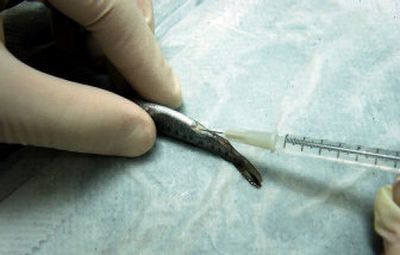UI researcher angling for fish vaccine

Rainbow trout might be native to Northwest streams, but chefs all over the world revere the fish’s firm, mild-tasting flesh. Thanks to aquaculture, fresh trout appears on menus from Tokyo to Tehran.
“In Japan, it sells quite well against the sockeye salmon,” said Jim Parsons, senior vice president of Troutlodge Inc. in Sumner, Wash. His company ships rainbow trout eggs for cultivation to 45 countries, including Iran.
In distant fish farms the eggs grow into pan-sized fillets. But each year an elusive killer called coldwater disease causes millions of dollars in losses for fish farmers. The bacterial disease sweeps through rearing ponds, killing vulnerable fingerling trout.
“You can lose 30 percent of them in a short time,” said Ken Cain, associate professor of aquaculture and fish health at the University of Idaho.
For the past six years, Cain has worked on developing a vaccine for coldwater disease. By injecting thousands of tiny trout – each weighing slightly more than a quarter coin – Cain and his graduate students determined that trout can build up immunity to coldwater disease, similar to the way that people get protection from flu shots. Cain’s now trying to identify which proteins in the bacteria trigger the immune response.
The work is painstaking. In one experiment, Cain theorized that adult fish that developed immunity to coldwater disease would pass the protection to their offspring. A graduate student injected hundreds of yolk sacs with a mild strain of coldwater disease, only to have the young fish come down with the disease.
A vaccine is probably still five to 10 years away, according to Cain. “It’s research,” he said, “so you never know for sure.”
The U.S. Department of Agriculture, however, has found the research so promising that it has pumped $500,000 into Cain’s work, some of which was conducted in cooperation with Washington State University and commercial trout farms.
In Idaho alone, coldwater disease costs fish farmers an estimated $10 million annually.
“It’s a severe economic impact, and not only from mortalities,” said Scott LaPatra, director of research and development at Clear Springs Foods in Buhl, Idaho. Fingerlings that survive a disease outbreak don’t grow as quickly. They can also develop crooked spines, sores on their skin, and other deformities. Even though the rainbow trout are still safe to eat, their market value drops significantly, LaPatra said.
Most of the nation’s farm-raised trout comes from the Magic Valley, a 30-mile stretch along the Snake River in south-central Idaho. Clear Springs Foods is at the forefront of the $100 million industry. The company produces more than half of Magic Valley’s yearly output of 41 million pounds.
Clear Springs raises the trout to a “pan-sized” 1 to 2 pounds, at which point the fish are harvested and sold as fresh and frozen fillets. Boneless pecan-encrusted fillets end up in restaurants. The company also produces pizza-flavored fish sticks for school lunch programs.
The Magic Valley is ideal for growing trout, LaPatra said. Even though the area is a high desert, springs from the walls of the Snake River canyon provide a constant supply of 58-degree water. Rainbow trout thrive in the cold water. Unfortunately, so do the bacteria causing coldwater disease. The disease gets its name because outbreaks are rare above 58 degrees.
The bacteria causing coldwater disease was first believed to be limited to North America but has since been detected worldwide. It also strikes other trout and salmon species, though the highest mortality rates occur in rainbow trout and coho salmon.
Rainbow trout have been the focus of research efforts because they represent such a large commercial industry, Cain said. Part of the challenge, however, is creating an affordable vaccine.
At farms raising Atlantic salmon, the fish are individually injected with vaccines. Operators can afford to do that with a 15- to 20-pound salmon, but it’s not cost-effective with a 1- to 2-pound trout, Cain said.
He’s aiming for a vaccine that could be absorbed through the gills.
For fish farmers to embrace it, the vaccinations couldn’t cost more than a few pennies per fish, Cain said.
“We’d prefer a half cent per fish,” said Clear Springs’ LaPatra. “At any given moment, we have 7.6 million pounds of swimming fish.”
That’s about 38 million individual trout, he said.